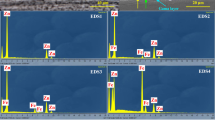Abstract
In this paper, corrosion potential and impedance response of the graphene-modified low-zinc waterborne epoxy anticorrosion coating with different compositions were measured experimentally. Microstructure impedance analysis approach was proposed, which was applied to analyze in detail the system impedance and to clarify the variation of coating state as well as the role of graphene in the coating. Results showed that the variation course of coating state was divided into four stages: activation stage; cathodic protection stage; shielding protection stage; and failure stage. Graphene formed numerous isolation layers in the coating to hinder the diffusion of aggressive particles like water and oxygen as well as corrosion products, which played a certain shielding protective role. Moreover, graphene was a good electron conductor, which enabled the outer layer zinc to continue to constitute a galvanic couple with the iron substrate after cathodic protection stage, thereby prolonging the protective effect of the coating to some extent.


























Similar content being viewed by others
References
H.H. Chua, B.V. Johnson, and T.K. Ross, The Protection of Mild Steel by Zinc-Rich Paint in Flowing Aerated 0.5 M NaCl Solutions—I, The Effect of Zinc Particle Size, Corros. Sci., 1978, 18(6), p 505–510
S.G. Real, A.C. Elias, J.R. Vilche et al., An Electrochemical Impedance Spectroscopy Study of Zinc Rich Paints on Steels in Artificial Sea Water by a Transmission Line Model, Electrochim. Acta, 1993, 38(14), p 2029–2035
S. Shreepathi, P. Bajaj, and B.P. Mallik, Electrochemical Impedance Spectroscopy Investigations of Epoxy Zinc Rich Coatings, p Role of Zn Content on Corrosion Protection Mechanism, Electrochim. Acta, 2010, 55(18), p 5129–5134
N. Hammouda, H. Chadli, G. Guillemot et al., The Corrosion Protection Behaviour of Zinc Rich Epoxy Paint in 3% NaCl Solution, Adv. Chem. Eng. Sci., 2011, 1(02), p 51
A. Gergely, É. Pfeifer, I. Bertóti et al., Corrosion Protection of Cold-Rolled Steel by Zinc-Rich Epoxy Paint Coatings Loaded with Nano-Size Alumina Supported Polypyrrole, Corros. Sci., 2011, 53(11), p 3486–3499
L. Zhang, A. Ma, J. Jiang et al., Anti-Corrosion Performance of Waterborne Zn-Rich Coating with Modified Silicon-Based Vehicle and Lamellar Zn (Al) Pigments, Prog. Nat. Sci. Mater. Int., 2012, 22(4), p 326–333
H.Y. Li, J.Y. Duan, and D.D. Wei, Comparison on Corrosion Behaviour of Arc Sprayed and Zinc-Rich Coatings, Surf. Coat. Technol., 2013, 235, p 259–266
K. Schaefer and A. Miszczyk, Improvement of Electrochemical Action of Zinc-Rich Paints by Addition of Nanoparticulate Zinc, Corros. Sci., 2013, 66, p 380–391
A.H. Sofian and K. Noda, Corrosion Resistance and Mechanism of Zinc Rich Paint in Corrosive Media, ECS Trans., 2014, 58(38), p 29–37
B. Ramezanzadeh, S.Y. Arman, and M. Mehdipour, Anticorrosion Properties of an Epoxy Zinc-Rich Composite Coating Reinforced with Zinc, Aluminum, and Iron Oxide Pigments, J. Coat. Technol. Res., 2014, 11(5), p 727–737
A. Kalendová, D. Veselý, M. Kohl et al., Anticorrosion Efficiency of Zinc-Filled Epoxy Coatings Containing Conducting Polymers and Pigments, Prog. Org. Coat., 2015, 78, p 1–20
N.T. Kirkland, T. Schiller, N. Medhekar et al., Exploring Graphene as a Corrosion Protection Barrier, Corros. Sci., 2012, 56, p 1–4
A. Tiwari, and R. K. S. Raman, Multilayer graphene coating on Copper for corrosion mitigation, Corrosion & Prevention 2013 (Geoffrey Will 10 November 2013 to 13 November 2013), Australian Corrosion Association Inc, 2013, p 1–7.
S. Mayavan, T. Siva, and S. Sathiyanarayanan, Graphene Ink as a Corrosion Inhibiting Blanket for Iron in an Aggressive Chloride Environment, RSC Adv., 2013, 3(47), p 24868–24871
C.M.P. Kumar, T.V. Venkatesha, and R. Shabadi, Preparation and Corrosion Behavior of Ni and Ni–Graphene Composite Coatings, Mater. Res. Bull., 2013, 48(4), p 1477–1483
M. Schriver, W. Regan, W.J. Gannett et al., Graphene as a Long-Term Metal Oxidation Barrier, p Worse Than Nothing, ACS Nano, 2013, 7(7), p 5763–5768
B.P. Singh, S. Nayak, K.K. Nanda et al., The Production of a Corrosion Resistant Graphene Reinforced Composite Coating on Copper by Electrophoretic Deposition, Carbon, 2013, 61, p 47–56
S.C. Sahu, A.K. Samantara, M. Seth et al., A Facile Electrochemical Approach for Development of Highly Corrosion Protective Coatings Using Graphene Nanosheets, Electrochem. Commun., 2013, 32, p 22–26
Feliú S, Barajas R, Bastidas J M, et al. Study of protection mechanisms of zinc-rich paints by electrochemical impedance spectroscopy, Electrochemical Impedance: Analysis and Interpretation. ASTM International, 1993
A. Meroufel and S. Touzain, EIS Characterisation of New Zinc-Rich Powder Coatings, Prog. Org. Coat., 2007, 59(3), p 197–205
A. Ambrosi, C.K. Chua, A. Bonanni et al., Electrochemistry of Graphene and Related Materials, Chem. Rev., 2014, 114(14), p 7150–7188
H. Marchebois, C. Savall, J. Bernard et al., Electrochemical Behavior of Zinc-Rich Powder Coatings in Artificial Sea Water, Electrochim. Acta, 2004, 49(17), p 2945–2954
Y.L. Zhang and S.P. Yang, Environmentally Friendly Adhesive Materials and Typical Formula, Chemical Industry Press, Beijing, 2010
G.Z. Qin and Z.M. Tian, Corrosion Prevention Technology and Application, Chemical Industry Press, Beijing, 2002
Acknowledgments
This work has been supported by Qingdao postdoctoral applied research project, Grant No. 2015307, Qingdao major projects of independent innovation, Grand No. 16-7-1-2-zdzx-xx, and Ningbo major scientific and technological projects, Grand No. Y60309DD03.
Author information
Authors and Affiliations
Corresponding author
Rights and permissions
About this article
Cite this article
Ding, R., Wang, X., Jiang, J. et al. Study on Evolution of Coating State and Role of Graphene in Graphene-Modified Low-Zinc Waterborne Epoxy Anticorrosion Coating by Electrochemical Impedance Spectroscopy. J. of Materi Eng and Perform 26, 3319–3335 (2017). https://doi.org/10.1007/s11665-017-2790-8
Received:
Revised:
Published:
Issue Date:
DOI: https://doi.org/10.1007/s11665-017-2790-8




